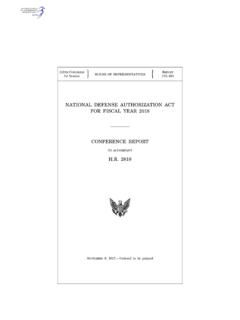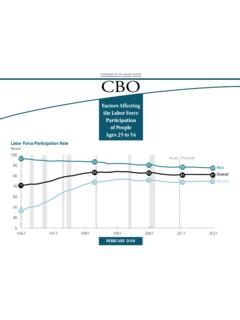Transcription of Ring the Alarm - United States House of Representatives
1 A report to congress from The Congressional black CaucusEmergency TaskForce on black youth Suicide and Mental HealthRepresentative Bonnie Watson Coleman, Task force ChairRing the AlarmThe Crisis of black youth Suicide in AmericaAcknowledgementsThis report would not exist without the efforts of the Working Group empowered by the Emergency Taskfore. Their dedication and willingness to lend both time and expertise have powered the Taskforce s work. Special thanks to the NYU McSilver Institute for their invaluable contributions in producing this Group ChairDr. Michael A. Lindsey, Executive Director of the NYU McSilver Institute for Poverty Policy and ResearchWorking Group MembersAzza Altiraifi, Center for American Progress Jasmin Pierre, The Safe PlaceDr. Donna H. Barnes , DHB Wellness & Associates, LLC Courtney Grey, Office of Public Health Preparedness: Boston, Massachusetts Dr.
2 Rhonda Boyd, Children s Hospital of Philadelphia Dr. Alfiee Breland-Noble, AAKOMA Project, Inc. Dr. Herb Conaway Jr., New Jersey Assemblyman (LD-7) Dr. Kia Darling-Hammond, Stanford University Dr. Jan Desper Peters, black Mental Health Alliance for Education & Consultation, Inc. Tracie Jenkins, Boris L. Henson Foundation David Johns, National black Justice Coalition Dr. Sean Joe, Washington University in St. Louis Dr. William Lawson, Consultant Institute for Reducing Disparities Through Research Dr. Sherry Molock, George Washington UniversityPastor Otis Moss III, Trinity United Church of Christ Dr. Annelle Primm, The Steve Fund Dr. Arielle Sheftall, The Research Institute at Nationwide Children s Hospital Pastor DeForest Buster Soaries, First Baptist Church of Lincoln Gardens Dr. Altha Stewart, American Psychiatric Association Rev.
3 Michael Walrond, First Corinthian Baptist Church Dr. Raynard Washington, Philadelphia Department of Health taskforce MembersRep. Bonnie Watson Coleman (Chair)Rep. Alma Adams (NC-12)Rep. Emanuel Cleaver II (MO-05)Re. Danny Davis (IL-07)Rep. Alcee Hastings (FL-20)Rep. Jahana Hayes (CT-05)Rep. Steven Horsford (NV-04)Rep. Sheila Jackson Lee (TX-18)Rep. Eddie Bernice Johnson (TX-30)Rep. Robin Kelly (IL-02)Rep. Barbara Lee (CA-13)Rep. John Lewis (GA-05)Rep. Eleanor Holmes Norton (DC)Rep. Ilhan Omar (MN-05)Rep. Ayanna Pressley (MA-07)Rep. Frederica Wilson (FL-24)Rep. Karen Bass (Chair, CBC)Table of ContentsExecutive Summary ..Page 1 Recommendations ..Page 5 Overview ..Page 21 Resources for Families and 32 IntroductionOver the last several years, data has emerged indicating an alarming increase in the suicide rates for black children and teenagers over the past generation.
4 While research has also shown climbing rates for youth from other racial and ethnic groups, this trend in black youth runs counter to historical data showing lower rates of suicide among black Americans. It challenges the public perception that black youth simply do not commit suicide. Additional research about suicidal behaviors has raised questions about whether the path from suicidal thoughts to attempts is well understood in black youth , and whether we have the knowledge and tools to intervene before the worst Summary1A Growing crisisIn youth ages 10 to 19 years, suicide is the second leading cause of death, and in 2017 , over 3,000 youth died by suicide in this age group. Over the past decade, increases in the suicide death rate for black youth have seen the rate rising from per 100,000 in 2007 to per 100,000 in 2017 .
5 black youth under 13 years are twice as likely to die by suicide and when comparing by sex, black males, 5 to 11 years, are more likely to die by suicide compared to their White peers. Finally, the suicide death rate among black youth has been found to be increasing faster than any other racial/ethnic examining suicidal ideation and behavior results have been mixed. Nonetheless, a new study using the youth Risk Behavior Survey (a national school survey of adolescent health behaviors developed by the Centers for Disease Control and Prevention) paints a further alarming picture for black high-school aged youth . That study s findings indicated that suicide attempts rose by 73% between 1991- 2017 for black adolescents (boy and girls), while injury by attempt rose by 122% for black adolescent boys during that time period.
6 This would suggest that black males are engaging in more lethal means when attempting suicide. Although black youth have historically not been considered at high risk for suicide or suicidal behaviors, current trends suggest the Challenge AheadThe narrowing racial gap in suicide rates tells us that this emergent issue among black youth warrants attention now. A cadre of black researchers from across the United States has been ringing the Alarm to raise awareness about this disturbing trend. Yet, very few research dollars have been committed by entities such as the National Institutes of Health (NIH), National Institute of Mental Health (NIMH) and the Substance Abuse and Mental Health Services Administration (SAMHSA) to investigate into what is happening; specifically, for evidence-based interventions relating to mental health and suicide risk; and studies about risk factors, protective factors, mental health utilization and engagement, as they pertain to black youth .
7 black scientists those most closely connected to this population are 10 percentage points less likely than White scientists to be awarded NIH research funding; and a recent study by NIH scientists concluded that research topics proposed by black scientists are less likely to be funded than those proposed by White a growing body of research on black youth suicide and mental health, news coverage of suicide trends among 1 To see the reference information for the aforementioned research, please see the full suicide death rate among black youth has been found to be increasing faster than any other racial/ethnic youth too often fails to mention specific developments related to black youth suicide, which urgently need First Steps Toward ActionThese are among the reasons that on December 6, 2018, Representative Bonnie Watson Coleman (D, NJ 12th District)
8 , who has been a long-standing advocate of the mental health needs of the black community, convened a congressional hearing that includ-ed some of the country s leading black researchers and practitioners to discuss mental health solutions for the increasing rates of suicide among black youth . An outcome of that hearing was a recommendation for the Congressional black Caucus to establish a taskforce to further examine black youth suicide and devise solutions, with regard to both legislation and other interventions. On April 30, 2019, the Congressional black Caucus (CBC) established the Emergency Taskforce on black youth Suicide and Mental Health (the Taskforce), with Rep. Watson Coleman as the chair. Upon its creation, the Taskforce empowered a Working Group of experts composed of the country s leading black academic, research and practicing Taskforce and the Working Group were charged with identifying causes and solutions for black youth suicide and mental health needs; developing and producing a report by the end of 2019; and describing the latest research, as well as practices and policy part of the fact-gathering process, the CBC and the Taskforce held a number of hearings on black youth suicide, including ones that focused on the impact of social media and the role of the faith community.
9 They also held a hearing to ascertain black youths perspectives on the issue of suicide and mental health. Taraji P. Henson, founder of the Boris L. Henson Foundation (which focuses on mental health), testified about mental health stigma and the barriers black people face in accessing treatment during a special hearing on June 7, Path ForwardThe intention of this report is to raise awareness; provide an overview on the existing body of research; identify gaps in research, policy and practice; highlight best practices for practitioners; and create a resource document for all who come into contact with black youth in healthcare, schools and other settings. The work of this Taskforce, in partnership with the CBC, will be ongoing and will include legislation; demonstration projects; regional roundtables; trainings; and engagement of policy makers on the federal, state and local levels.
10 Most importantly, the Taskforce would like for this report to serve as a vital resource for the parents and caregivers of black report is dedicated to the families of black youth , and to the children who have called our attention to this urgent matter. We know that suicide is a difficult topic to discuss; and while there are some very technical aspects to what is contained in this report , we have included the glossary in recognition that this report must be as accessible to is much work to be done within schools, the allied mental health professions, health institutions, funders and government entities to provide the necessary investment and training to properly address the mental wellness needs of black youth . We must reverse the trends for suicide and ensure that more black children and teens are received and engaged in mental health this report serve as an urgent call to action for all growing crisis in the mental health and well-being of black youth has been described in this report .





